Narkomfin building
The Narkomfin Building is a block of flats at 25, Novinsky Boulevard, in the Central district of Moscow, Russia. Conceived as a "transitional type of experimental house"[1], it is a renowned example of Constructivist architecture and avant-garde housing design.
| Narkomfin Building | |
|---|---|
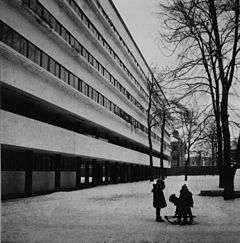 The Narkomfin building in the 1930s | |
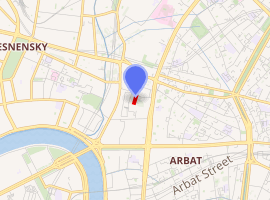
| |
| General information | |
| Architectural style | Constructivism |
| Location | Moscow, Russia |
| Construction started | 1928 |
| Completed | 1930 |
| Design and construction | |
| Architect | Moisei Ginzburg, Ignaty Milinis |
| Architecture firm | OSA Group |
Though a listed "Cultural Heritage Monument" on the Russian cultural heritage register, it was in a deteriorating state for many years. Many units were vacated by residents. A reconstruction, which lasted more than three years, was completed in the summer of 2020, with the official opening of the renovated apartment building took place on 9 July.
Architecture for collective living
The project for four planned buildings was designed by Moisei Ginzburg with Ignaty Milinis in 1928. Only two were built, completed in 1932.
This apartment block, designed for high rank employees at the Commissariat of Finance (shortened to Narkomfin) was an opportunity for Ginzburg to try out many of the theories advanced by the Constructivist OSA group between 1926 and 1930 on architectural form and collective living. The building is made from reinforced concrete and is set in a park. It originally consisted of a long block of apartments raised on pilotis (with a penthouse and roof garden), connected by an enclosed bridge to a smaller, glazed block of collective facilities.
As advertised by the architects, the apartments were to form an intervention into the everyday life (or byt) of the inhabitants. By offering Communal facilities such as kitchens, creches and laundry as part of the block, the tenants were encouraged into a more socialist and, by taking women out of their traditional roles, feminist way of life. The structure was thus to act as a 'social condenser' by including within it a library and gymnasium.
On the other hand, architects of the 1920s had to face the social reality of an overcrowded socialist city: any single-family apartment unit with more than one room would eventually be converted to a multi-family kommunalka. Apartments could retain the single-family status if, and only if, they were physically small and could not be partitioned to accommodate more than one family. Any single-level apartment could be partitioned; thus, the avant-garde community (notably, Ginzburg and Konstantin Melnikov) designed such model units, relying on vertical separation of bedroom (top level) and combined kitchen and living room (lower level). Ilya Golosov implemented these cells for his Collective House in Ivanovo, and Pavel Gofman for communal housing in Saratov[2]. Ginzburg refined their cell design based on real-life experience.[3]
Vertical apartment plan
Narkomfin has 54 units, none of them has a dedicated kitchen - at least, legally. Many residents partitioned their apartments to set aside a tiny kitchen. There are five inhabited floors, but only two corridors on second and Fifth level (an apartment split between third and second level connects to the second floor corridor, etc.).
Apartments were graded by how far along they were to being 'fully collectivised', ranging from rooms with their own kitchens to apartments purely for sleep and study. Most of the units belong to "Cell K" type (with double-height living room) and "Cell F" connecting to an outdoor gallery. The sponsor of the building, Commissar of Finance Nikolay Alexandrovich Milyutin, enjoyed a penthouse (originally planned as a communal recreation area). Milyutin is also known as an experimental city planner who had developed plans for a linear city.
Influence
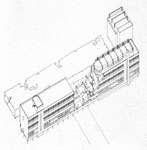
Le Corbusier, who studied the building during his visits to the Soviet Union, was vocal about the debt he owed to the pioneering ideas of the Narkomfin building, and he used a variant of its duplex flat plans in his Unité d'Habitation. Other architects to have reused its ideas include Moshe Safdie, in his Expo 67 flats Habitat 67 and Denys Lasdun, in his luxury flats in St James', London. The idea of the 'social condenser' was also acknowledged by Berthold Lubetkin an influence on his work.
The Narkomfin building as reality
The Utopianism and reformism of everyday life that was behind the building's idea fell out of favour almost as soon as it was finished. After the start of the Five Year Plan and Joseph Stalin's consolidation of power, its collectivist and feminist ideas were rejected as 'Leftist' or Trotskyist. In the 1930s, the ground floor, which was originally left free and suspended with pilotis, was filled with flats to help alleviate Moscow's severe housing shortage, while a planned adjoining block was built in the eclectic Stalinist style . The building looks over the US embassy, which has discouraged the inhabitants from using the roof garden. The vicissitudes of the building were charted in Victor Buchli's book An Archaeology of Socialism which takes the flats and their inhabitants as a starting point for an analysis of Soviet 'material culture'.[4]
Threatened landmark
The Narkomfin Building has been under-maintained for the last three decades, and is in a very dilapidated state, although it is still partially inhabited. There have been various proposals to save the building, which has been under threat of demolition, either by turning it into luxury flats or a hotel. It is located in an area of particularly lucrative real estate now, between properties of the Embassy of the United States in Moscow.
Legally, each apartment unit in the building was privatized (beginning in 1992) by the residents. Later, a real estate speculator bought out a significant proportion of the apartments, as a consolidated apartment package with the city MIAN agency. The rest is still owned and inhabited by the residents, but with MIAN dominance creating a legal stalemate where the residents are unable to form a condominium association and operate the building independently of municipal authorities. Thus, the city agency has control over the future of the Narkomfin building.
The building has been at the centre of controversies in recent years, including accusations that illegal renovations were taking place. "The situation is out of control," said Alexei Ginzburg, grandson of Narkomfin's architect Moisei Ginzburg in 2014.[5]
MIAN now intends to remodel the Narkomfin building into an apartment hotel, and commissioned Alexey Ginzburg to redesign the new interior structure. They expect renovation costs to be under US$20,000,000, while the real estate prices in this area approaches US$20,000 per square meter. Usually city-backed developers have no problems with evicting former residents from older buildings, especially when many of the residents have already voluntarily vacated apartments. However, public protests against redevelopment of the Narkomfin appear to have stalled the reconstruction process.
Protection
Russian code on listed "Cultural Heritage Monument" buildings prohibits any major re-planning of internal walls and partitions.
The Narkomfin building is at the top of the UNESCO 'Endangered Buildings' list. It has been on the World Monuments Fund's Watch list of endangered heritage sites three times. There is an ongoing international campaign to save the landmark.[6][7]
Gallery
| Wikimedia Commons has media related to Narkomfin Building. |
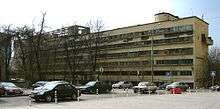 View from Garden Ring (east)
View from Garden Ring (east) View from west
View from west View from south
View from south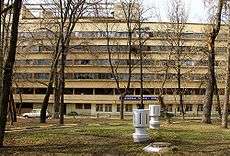 View from Feodor Chaliapin home and park (east)
View from Feodor Chaliapin home and park (east)
 Renovation work in progress, 2019
Renovation work in progress, 2019
References
- Movilla Vega, Daniel (2020). "Housing and Revolution: From the Dom-Kommuna to the Transitional Type of Experimental House (1926–30)". Architectural Histories. 8 (1).
- Pavel Gofman communal housing in Saratov; photographs Archived 2007-09-27 at the Wayback Machine
- Russian: C.O. Хан-Магомедов, "Константин Мельников", p.56–59
- Victor Buchli, An Archaeology of Socialism; Berg, 2000.
- The Moscow Times: Constructivist Utopia Narkomfin Endangered by Renovation Project
- The Charnel-House (architecture blog): "Dom Narkomfin in Moscow, 1929 — "Moisei Ginzburg & Ignatii Milinis' iconic constructivist masterpiece" . accessed 11.23.2013
- Architectural Review—RUINS OF UTOPIA blog: Moscow’s Narkomfin Building — essay and images. accessed 11.23.2013
External links
- Moscow Architecture Preservation Society Profile
- Campaign for the Preservation of the Narkomfin Building
- The Art Newspaper on the Narkomfin
- zdanija.ru Russian forum: photos of the Narkomfin Building
.